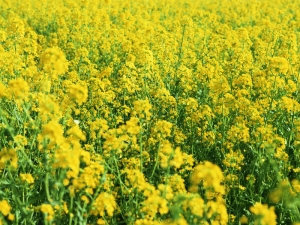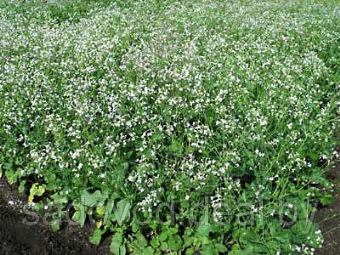Oilseed radish: scope and agricultural engineering

Oilseed radish is a crop that grows on different soils. Her closest relatives are radish and radish.This plant can be seen everywhere in the open spaces of our country - from Kaliningrad to Kamchatka. Olive radish is used as green manure, honey plant and fodder culture.
Characteristic
Oil-bearing radish or Raphanus oliefera is an annual plant of the Cabbage family. It is distinguished by a branched stem and foliage saturated green color. Radish reaches a height of one and a half to two meters in height. When it blooms, inflorescences of white-pink or bright yellow pyramidal shape are formed on it. For the peculiarity of the flower (the presence of 4 petals), it is attributed to the cruciferous subspecies.
Radish has a lot of leaves holding well on stalks. Looking at it from above, when it expanded, the soil layer does not appear. Next to it, ordinary and viable weeds do not get along, for example, ragweed and couch grass. Having sown it, gardeners "forget" about wheatgrass with its developed rhizomes, since the essential oils that produce leaves and oilseed radish flowers will still destroy the weed.
Oilseed radish has long roots. They penetrate deep into the soil layer, transporting nutrients to the surface. The plant is not afraid of frost, drought, grows even in the shade and loves the abundance of moisture. If gardeners forget to water it, but there is no precipitation, developed roots will take it in the deep layers. Both with early and late planting, the culture will not disappear, it takes root deeply and grows quickly. The main feature of oilseed radish - unpretentiousness. It adapts to any weather, temperature and soil composition.
The plant has the following properties:
- rapid growth despite poor quality ground;
- abundance of vegetative mass;
- improving the structure of clay soil due to the powerful roots of the plant;
- cold resistance;
- improving the habitat of worms;
- not afraid of thickening;
- promote better nitrogen binding;
- providing phytosanitary effects, suppressing the activity of roundworm-parasites, because of which roots spoil plants, roots die, stalks crack, leaves curl;
- the fight against cabbage "Kila", which threatens the development of other cultures.
Where applicable
Oilseed radish has found wide application in cosmetology, cooking, pharmacology, the production of fuel and lubricants.
Cooking
Although the oilseed radish has no root crops, and the seeds obtained from the pods are not beans, they are used in cooking. Vitamin salad is made from it, pre-soaking young leaves in cold water and adding other ingredients to your taste. You can cook and delicious soup, adding a plant for a couple of minutes until done.
Cosmetology and Pharmacology
Oil is obtained from the seeds, but this process is long and expensive. If it fell on the shelves, the price for it would be transcendental. Therefore, in the food industry, oil is not used, but it has found its application in the manufacture of drugs and as a component in the composition of cosmetics.
Pharmacology
From the plant emit essential oils and essences. They make vitamins and dietary supplements. Having dried the foliage of the plant, it is subsequently used in the preparation of herbal preparations. Drinks resulting from them, soothe and relieve stress. They muffle migraines caused by cramps due to an increase or decrease in pressure.
Cosmetology
Dedicated essential oils from the leaves and flowers of the plant are included in the composition of ointments and means for massage. Their value lies in the fact that when massaging the skin is saturated with valuable substances, and in the epidermis a warming effect will be created. Adding oils to balms and hair masks will help make them more elastic and silky.
For production needs
Oilseed radish - raw materials for the production of diesel fuel and components of waterproof greases for the open parts of the mechanisms of metal in the open air
Properties
Oilseed radish can perform various purposes.
As siderat
Siderats are cultures that enrich the earth with high-grade nitrogen and organic matter. They have developed roots. Therefore, they are able to raise phosphoric acid, magnesium, calcium, etc. from the deep layers to the surface. This has the best effect on nutrition and the full development of all garden crops. Remains of green crops that were grown in the garden a year ago, are processed thanks to special microorganisms. The soil turns into humus without the introduction of nutrient mixtures and chemicals.
There is no problem with sowing and taking care of siderats. They are unpretentious, while in the next season the indicators of the soil mixture improve and its productivity increases. The soil is enriched with nutrients. Among all the green manures known to agricultural technicians, the best is oilseed radish, since the following features are inherent in it:
- rapid growth of the vegetative mass;
- root development;
- obstructing the growth of weeds;
- protection of soil from drought, weathering, heating and freezing;
- the destruction of parasites and diseases;
- possibility of use as a natural fertilizer instead of chemical dressings.
One year of cultivation of this siderat on a bed is enough to increase the yield of vegetables sown after it. It is undesirable to plant daikon, cabbage or tuberous radish on the garden bed after it.
Agrotechnics recommend waiting a year or two with their landing. Other plants are planted without looking back, and then they are surprised by their pomp and yield increase several times.
Oilseed radish as a siderat protects the soil from erosion, which is strong during the off-season. Even without putting the beds in order in the autumn, in spring, summer residents with surprise discover that the ground was not frozen. Moreover, such an “omission” contributes to the rapid absorption of moisture by the soil. For a year of experimental planting of a crop, twenty-five kilograms of phosphorus, eighty-five kilograms of nitrogen and 100 kg of potassium accumulate in one hectare of land.
Agrotechnics recommend planting this crop to cottagers who notice that vegetables often get sick on the site. Oilseed radish fights cabbage "Kila", destroys aphids, potato scab, caterpillars, and all this without the use of additional pesticides. Sowing culture near the grapes, you will accelerate the growth and formation of the vine.
Like honey plant
Oilseed radish is not only a great siderat. She is an excellent honey plant, whose qualities are recognized by beekeepers from different corners of the globe. The main feature of the culture is that the bees collect nectar from it, even in cold weather and cloudy weather in early spring or in the middle of summer, when other honey plants have already moved away. Radish contains many monosaccharides, i.e. fructose, sucrose, glucose.
Honey from nectar of oil radish crystallizes quickly in honeycombs. Because of this, you can not leave it in the hives for the winter. It emanates a strong aroma. It is widely used for medicinal purposes. You cannot keep such honey for more than a year, because due to the rapid thickening of the useful properties of the product will evaporate.
As feed crop
Along with fodder radish, oilseed radish is fed to cattle. Its advantages are fast growth, excellent ripening and yield. From 1 hectare of planting, 300-400 centners of fodder mass are obtained, and if we organize its irrigation, fertilization, the yield rises to 700 centners. From the moment of sowing the seeds to harvest, it takes only 1.5 months. For the season (depending on the climate that prevails in the area) successful farmers harvest up to three harvests of tops.
Unlike fodder radish, oilseeds do not have root crops. Cattle fed to the tops, energy indicators which are similar to the feed, clover and alfalfa. In radish about 26% protein, enough amino acids, iron, potassium and zinc. If you make a bevel during the flowering period, then the tops will be rich in vitamin C, carotene. Cattle do not feed only oilseed radish.It is used as a raw material for silage, briquettes, grass meal and haylage. It is mixed with oats and peas during ensiling. When growing as animal feed, experts advise planting it near cereals, legumes, and sunflower.
Growing up
Depending on the climate in the cultivation area, the timing of sowing and harvesting vary. Not everywhere in the Russian Federation during the season they harvest three crops. When sowing, consider the following: oil radish sown for the first time, as soon as the snow melts in the fields (early spring), and the last - forty days before frost, predicted by weather forecasters (late autumn).
The technology of cultivation varies depending on the purpose of sowing oilseed radish. If plants are grown for fertilizing the soil and air exchange in it, it is mown after the first flowers appear. In some regions of the Russian Federation, they manage to mow the plant four times for these purposes. When sowing, seeds are buried three to four cm deep into the ground, and the optimal distance between rows is 15 cm. Seeding rate: 2 g / 1 sq. M. meter, if they grow radish as green manure; 4-5 g / sq. meter, if it goes to household needs or for animal feed. Consumption - 18-25 kg of seeds per 1 ha. After sowing, the top layer of soil is crushed, and the first shoots are noticed after four to seven days.
When grown as a silo, they mow olive radish before mass flowering. A little late with the mowing, the milk from cows will acquire a special taste due to the abundance of essential oils in the plant. Growing radish as green manure, they carry out the process of humification. Landings are deeply dug up as soon as the vegetative mass grows. After two or three weeks, the culture decomposes in a moist soil mixture.
To speed up the process, it is recommended to use concentrates “Baikal-EM-1” or “Vostok-EM”. They need to water the area before cultivation. The process of humification will contribute to filling the site with humus and organic fertilizers. There is another way to fertilize the earth. Siderat is left in the ground for the winter. By spring, it will turn into a beautiful humus, which can be used for growing garden crops.
Video review of honey radish oilseed, see below.










































